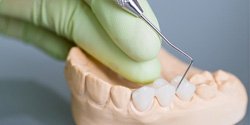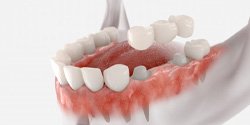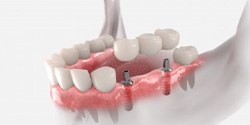Dental Bridges – Edmond, OK
Replacing Multiple Teeth In a Row

Are you missing one or several pearly whites consecutively? Instead of replacing each one individually, our team can simply renew your smile with dental bridges in Edmond. These restorations consist of two dental crowns connected by pontics, which can effectively close the gap between your teeth. Not only is this more straightforward, but the materials we use will provide a lifelike and reliable solution that’ll blend well with the rest of your smile. After just two visits, you’ll be free to show off your renewed pearly whites! Read on or give us a call today to learn more about dental bridges.
Why Choose Bluff Creek Dental for Dental Bridges?
- Natural-Looking & Durable Dental Materials
- Use State-of-the-Art Technology for Custom Designs
- Highly Experienced & Caring Dental Team
What Is a Dental Bridge?

A dental bridge tooth replacement prosthetic is composed of three main pieces: the replacement tooth or teeth (also known as pontics) and two dental crowns attached to both sides of the prosthetic teeth. To bridge the gap in your smile, the dental crowns need to be cemented into place over the top of two healthy teeth on either side of the lost teeth. This seamlessly recreates your lost dental structures. Before then, our team will need to prepare your adjacent pearly whites by removing a portion of their enamel to make room for the crowns.
Types of Dental Bridges

Once you’ve scheduled an initial consultation with our team, we’ll assess your oral situation, review your medical/dental history, and walk you through the type of dental bridge that would be ideal for you. These include:
Traditional Dental Bridge

The traditional dental bridge will be made up of two dental crowns that will be supported on either side of the gap by the nearby healthy teeth. Of course, we’ll have to prepare your natural teeth first by shaving down some of the enamel so that there’s space for the dental crowns. After the bridge has been cemented in position, you’ll be free to use your newly restored smile.
Implant Bridge

This option is similar to a traditional bridge except we won’t need to prepare any of your healthy pearly whites. Instead, we can embed dental implants into your jawbone to support the restoration, preserving your natural smile while also promoting stronger bone tissue. Your results can typically last decades or a lifetime with proper care.
The Benefits of Getting a Dental Bridge

Some of the benefits of dental bridges include:
- Rebuild one or several missing teeth
- Lifelike restoration for a seamless blend with your smile
- Avoid dental shifting due to tooth loss
- Simplify oral hygiene
- Can last 15 years or more with proper maintenance
- Can maintain a stronger jawbone (with implant bridge)
Dental Bridges FAQs

Dental bridges are a quick, low fuss option to replace a tooth that you’ve lost. However, replacing any kind of tooth can be a pretty massive change, which means that you may very well have questions about what to expect from the dental bridge treatment.
We will talk to you about any concerns that you have, but before then, here is a collection of several questions that we tend to get about dental bridges.
Is Getting a Dental Bridge Painful?
Before removing any amount of enamel from your teeth, we will apply a local anesthetic so that you won’t be able to feel that part of the procedure. For that reason, you can be confident that getting dental bridges will be completely painless.
After your new prosthetic is in place, you may be tender for a few days. This should be mild and can be easily circumvented with OTC pain medicine, but if you notice that this gets worse over time, be sure to give us a call so we can check for problems.
How Long Should a Dental Bridge Last?
The exact lifespan of your dental bridge will depend on several factors, but in general, you can expect yours to last anywhere from five to fifteen years. Material is partially a factor in this, with metal dental bridges lasting sometimes longer than ceramic, but the larger variable is how well you take care of your dental bridge once you have it.
Your diet, your dental hygiene, and lifestyle choices like smoking can all contribute either positively or negatively to your dental bridges’ longevity. We’ll be able to talk to you a little bit about what you can do for a dental bridge at your consultation.
Can Dental Bridges Be Whitened?
Teeth whitening is done via a gel that’s placed on the teeth, one that penetrates the enamel and lifts stains from within it. This is possible because enamel is porous.
Whether you get metal or metal-free dental bridges, the material used will not be nearly as porous as your natural enamel. Consequently, teeth whitening isn’t going to work on them. Instead, you’ll need to be proactive—you may want to instead get teeth whitening before getting your dental bridge, then get them color-matched to your new smile.
How Do I Clean Under My Dental Bridge?
Given the structure of dental bridges, you’ll need to set aside time as a part of your daily dental hygiene to clean underneath it, removing food particles from the area between your restoration and your gums. Otherwise, bacteria could begin to flourish along the gumline.
Thankfully, there are several ways to do this easily:
- Floss threader: these are like soft plastic sewing needles that can fit in tight spots much more easily than floss on its own. This makes it easier to slip the floss beneath your dental bridge.
- Interdental brushes: sometimes called “Christmas tree brushes,” these are small pieces of plastic designed to fit easily between the teeth.
- Oral irrigators: these use pressurized water to blast away plaque and bacteria. While they’re convenient, they aren’t quite as effective at removing plaque as floss is. Still, they can be a great option for patients with dexterity issues.
